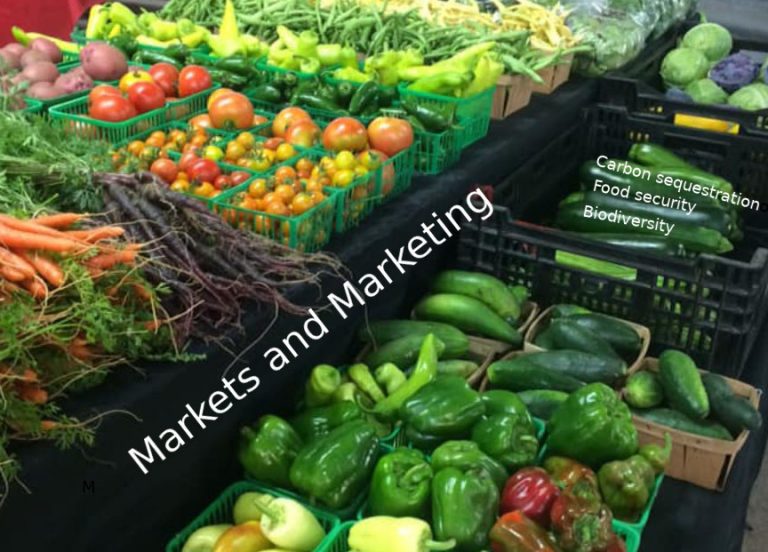Getting Started in Agroforestry: Part 2, Markets
by George Powell
Agroforestry markets and marketing is one of the five key areas you should explore before establishing a new venture. After setting your production and conservation goals, your next planning step should focus on markets.
Where and how you sell the ‘fruits’ of your labour is ultimately the most important factor in the success of agroforestry or any agricultural endeavor. Producing the perfect berry crop, or veneer log, or experience, can bring satisfaction in, and of, itself. But if you can’t sell what you produce, you will fail.
And you can’t eat satisfaction, nor make a mortgage payment with it.
Start from the Market and Work Backwards
Market considerations are so important, you should use them to filter your production interests up front.
Starting from the market for agroforestry products and working backwards towards a production goal, can therefore a be good strategy. Doing so will minimize costly mistakes in how you structure or scale the size of your agroforestry venture.
Market Outlets
Understanding your market outlets up front, empowers you to make rational investment decisions. Over or under investing can be equally fatal to a start-up, depending on the market you are trying to capture.
At the risk of over simplifying, there are essentially three basic market outlets for agroforestry production:
- Commodity markets for food and fibres (including wood), where you are a price-taker;
- Specialty markets, where, with or without value-added processing, you have restricted supply and can set prices. Although there are still upper bounds to what you can charge; and,
- Experiences. Where you can capture revenue from customers that want to immerse themselves in the production setting or in what you are doing.

Research Your Competition
Visit your local and regional farmers’ markets to get a sense of what others are selling. Go through your local big box / small box retailers and assess how much shelf space they dedicate to various food, natural health and other product categories. ‘Borrow’ on the local market research that companies do to find their right product mix. Retail has such tiny profit margins, they spend a great deal of time ensuring they only stock the shelves with things that will sell. And sell in volume.
Looking at their product offerings also provides the chance to establish competitive a niche. By offering up something within the same broad category that sells well (e.g. herbal teas), but is otherwise unique with regards to quality, flavour, etc.
For commodity sales, research where the wholesale buyers are and if product is sold through auction or contract. Talk with a few wholesale buyers and determine their minimum purchase volumes and quality standards.
Scale Production to an Addressable Market
After you explore and categorize the agroforestry markets and marketing options, you need to plan the scale of your operation. Scaling and structuring your production to an addressable market is crucial to ensure viability. Scale too small for a commodity market, and you may not have enough income to offset costs. Scale too large for a niche market and you may be sitting on a pile of unsold, sometimes perishable, inventory.
Let’s look at scale in the context of each of three market outlets.
Commodity Markets
For commodity markets, cost containment and mazimizing outputs should be your primary goals. You have little or no control over the price you will receive. You do have a measure of control over your costs.
Selling into the commodity markets means you will often only break-even or incur small losses in some years. To this end, it is often a strategy of cash flow over profitability. You can use the sales generated to keep your venture alive. And, over time, you build wealth in the capital appreciation of your land, trees or herd.
Specialty Markets
Specialty markets serve a niche in product quality or variety. A niche that cannot be found in mainstream, high-volume commodity channels.
With specialty markets, the key to success is scaling your operation so that it meets, but does not exceed, market demands.
Local farm markets or direct to consumer sales are a great avenue for an agroforestry start-up. But these markets can also saturate quickly.
If you scale production beyond what direct outlets can absorb, you may find yourself trapped in a ‘no market’ zone: too much volume for the local, direct to consumer channel. And, too little for the minimum volumes required for wholesale or larger regional or national markets.
Experiences
Selling experiences requires a somewhat different mind-set from selling products. The ‘transaction’ takes longer to complete. Customer relations and their sharing of those relationships with others are paramount to your success. All of which involves a sizable time commitment, which cannot always be reconciled with your production demands.
Success in selling experiences, is about building relationships and good PR. You don’t get to have a ‘bad day’ when your product is the relationship. In this regard, if you are not a social person by nature, it’s probably best not to engage in the highly social realm of selling experiences.
Marketing Plan
After your initial exploration of agroforestry markets and marketing, start outlining a formal marketing plan. This plan should include your target markets and expected range of sales. Also, importantly, the minimum production volumes and quality considerations attached to these markets.
The viability of setting up agroforestry production to address these markets can then be tested in your next planning consideration: your available finances and other resources.
Subscribe via RSS
